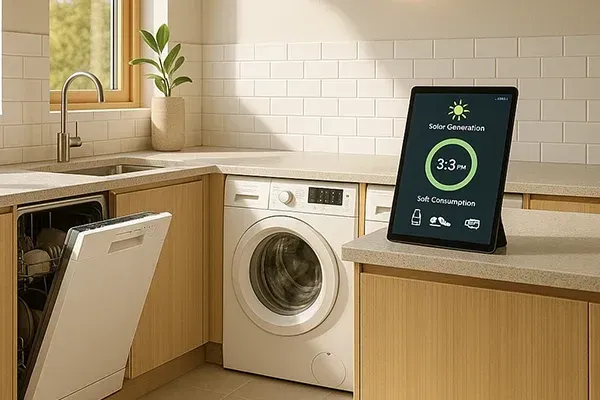Jousto Energy Hub — Start Smart. Automate Everything.
We’ve simplified home energy automation into three clear steps. Start with the Jousto Energy Hub, generate ready-to-paste YAML from our Genius chat, and if you get stuck, a vetted Fiverr expert can finish it for you.

 Smarter Energy for Everyone
Smarter Energy for Everyone
Your path to a truly smart energy home
From zero to automated in three simple steps — hardware, automations, and optional expert help.
Step 1 — Jousto Energy Hub
The Hub is your always-on energy brain. It connects solar, battery, EV, heat pump and smart plugs and runs our best-practice automations for Aussie homes.
Step 2 — Home Assistant Genius
Describe the automation you want (“charge EV from solar above 2 kW, pause on clouds, resume at 11am”). The Genius returns the exact YAML + step-by-step setup.
Step 3 — Expert help (optional)
Stuck? We’ve partnered with a vetted pool of Home Assistant experts on Fiverr. Share your YAML and brief; they’ll implement and polish.
Type your goal → Get YAML + instructions
Paste the YAML into Home Assistant and refresh. Our Genius also prints step-by-step instructions and checks common pitfalls.
Tip: Keep your device/entity names handy (e.g., sensor.solar_export_power, switch.pool_pump, climate.lounge_ac).
How it works
Connect the Hub
Plug in power + Ethernet. The Hub discovers your solar, battery, EV charger and smart devices.
Describe your automation
In the Genius, type what you want. It writes YAML and a step-by-step guide.
Paste the YAML
Load it into Home Assistant. Refresh. Toggle on. Done.
Popular automation recipes
A few prompts to try in the Genius right now.
Solar-first EV charging
“Charge EV only from excess solar above 2 kW; pause on clouds; allow grid top-up after 11pm on off-peak; target 80% by 7am weekdays.”
Smart hot water
“Run heat pump HWS 10am–3pm when exports exceed 1.5 kW; skip if tank at 55°C; force an hour at 8pm if below 45°C.”
Comfort + savings HVAC
“Pre-cool house to 23°C when solar >1 kW and outside <32°C; after 5pm hold 24–25°C using battery above 40%.”
Common questions
Do I need the Hub to use the Genius?
Will this work with my inverter/battery?
What if I can’t get the YAML working?

Maximise Your Solar Self-Consumption
How to Maximise Your Solar Self-Consumption with a Home Battery
Smart Strategies to Use More of Your Own Power and Lower Your Bills
Solar panels are great—but if you're sending most of your energy back to the grid for a few cents per kWh, you’re not getting the full benefit.
That’s where self-consumption comes in.
Simply put: The more of your solar energy you use yourself, the less you pay for electricity.
Adding a battery helps store your solar for night-time use. But even with a battery, how you use your appliances and manage your system can make a huge difference.
Let’s break it down.
⚙️ What Is Self-Consumption?
Self-consumption means using your solar power directly within your home or business—rather than exporting it.
Currently in Australia, feed-in tariffs are as low as $0.00–$0.06/kWh, while grid electricity can cost $0.30–$0.45/kWh. That’s a massive gap. When you store your solar and use it during peak times, you keep the value instead of giving it away.
🪜 5 Ways to Maximise Self-Consumption
1. Use High-Energy Appliances During the Day
Shift energy-hungry tasks—like laundry, dishwashing, or pool pumps—to daytime when your solar is generating.
2. Charge Your Battery First, Not the Grid
Many systems can be configured to prioritise battery charging during peak solar hours. That stored power then covers your night usage.
3. Reserve Power for the Evening Peak
Smart batteries let you set aside a portion of charge for use after sunset, when grid power is most expensive (around 6–10pm).
4. Automate Appliance Use
Use timers, smart plugs, or systems like the Jousto Energy Hub to turn on devices when solar generation peaks.
5. Stay Efficient
Less is more. Energy-efficient appliances + smart timing = more of your solar goes further. Every kWh you don’t waste saves you 30–45¢.
🧠 Bonus: Smart Energy Systems
If you’re using the Jousto Energy Hub, you can automate all of this. It learns your usage, checks solar forecasts, and schedules your devices and battery automatically.
It’s like having a solar-savvy energy manager in your pocket.
🧾 Real-World Savings
In South Australia, where grid power can cost up to $0.50/kWh during summer peaks, even a small 5–10kWh battery can save you $700–$1,200/year—just by using your own energy smarter.
📈 Want to Go Further?
If you already have solar but no battery, or if your current system isn’t configured for smart use, you’re leaving money on the table.
🔧 Your Next Step:
💬 Want the fully installed battery experience? Let us do it for you →
🛒 Want to buy a battery and DIY install? Explore our store →
COMPANY
PRODUCTS
SERVICES
JOUSTO ENERGY HUB
BATTERIES

© Copyright 2025.Honen Lead Generation.
All Rights Reserved.
Phone: 0489 261 333
185 Morphett St, Adelaide, SA, 5000
